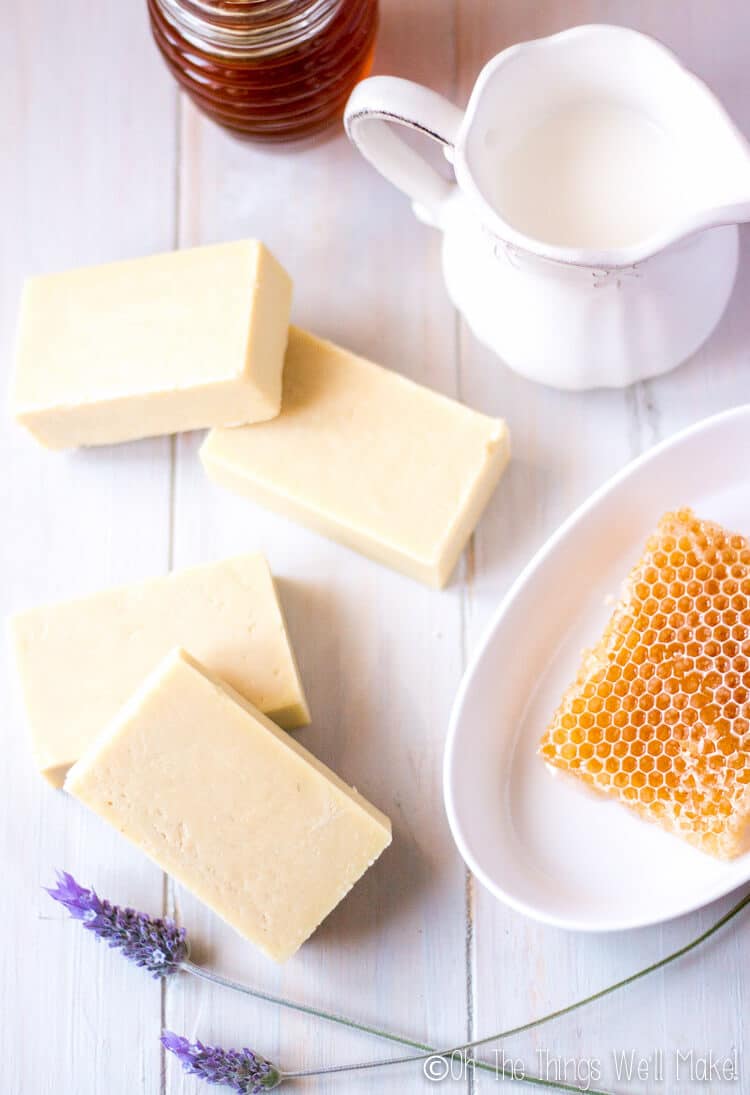
Gentle on the skin, and with a nice, creamy lather, this goat milk soap with honey is one of my favorites. Learn how to make soap with both milk and honey from scratch with this recipe.
Many of you have been asking for either a soap made with goat milk or one made with honey, so I decided to kill two birds with one stone and teach you how to make a soap with both goat milk and honey.
Because of the sugars in both milk and honey, they do provide a slight challenge when using in soap making, but I’ll share my tips and tricks to ensure you end up with pretty, light-colored bars of soap.
Watch how to make this goat milk soap with honey
Goat milk soap
Using milk in soap is a wonderful way to make a soap that is gentle on sensitive skin. It can help with eczema and psoriasis, and also has a nice, creamy lather.
I introduced working with goats milk in my pumpkin spice soap recipe, which as really just an adaptation of the easy, beginner soap. So many people asked for a goats milk soap, though, that I decided to formulate a new recipe which focused more on it and the techniques that can be used when working with it.
Adding milk to soap without burning it
While not difficult, working with milks in soap making can be slightly tricky. You need to take a few steps to ensure that the milk doesn’t burn when you mix it with the lye. Even when making a cold processed soap like this one, the heat from the reaction of the water and milk with the lye can cause the sugars in the milk to burn if you aren’t careful, resulting in a not-so-pretty, dark-colored bar that may even give off an unpleasant odor.
There are a couple of ways to prevent the milk from scalding. Most people freeze the milk before mixing it with the lye, and that method has always worked well for me. The heat generated when you mix the lye together with the liquids will melt the frozen milk rather than burn it. Those who don’t want to bother with pre-freezing can choose to add the milk at trace instead. (Trace is the point in soap making when the lye has emulsified with the oils and the soap is ready to be poured into molds.) At trace, there isn’t enough lye left to cause a heated reaction when the milk is added.
One of the benefits of freezing the milk is that you could potentially use a higher percentage of milk in your recipe. If you want to add the milk at trace, you’ll need to use enough water or other liquid, apart from the milk, to make the necessary lye solution for making the soap before adding in the milk.
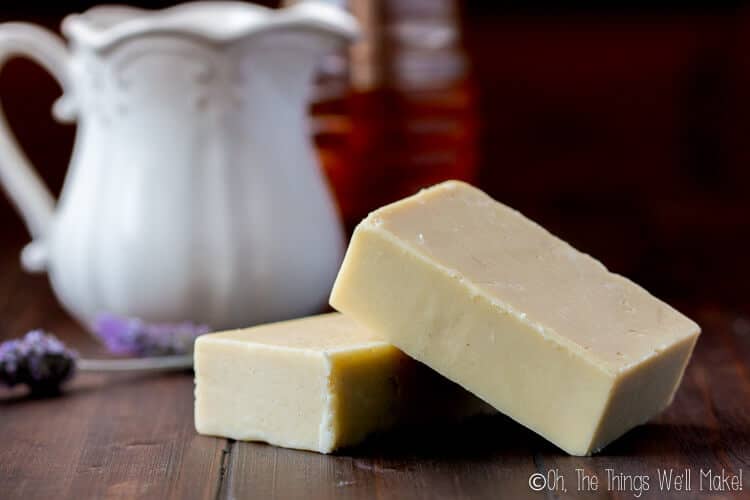
Should you try to reach the gel phase with goat milk soap?
If you aren’t familiar with the gel phase, it’s basically a point in soap making when higher temperatures are reached and the soap begins to look gel-like. You can recognize a soap that has reached the gel phase because it normally gets a slightly translucent look to it which often makes the soap also look slightly darker. Some people aim to get their soaps to the gel phase, especially when working with colorants so that their soaps show off brighter, more vivid colors. Gelled soaps also tend to get slightly harder more quickly, probably because the soaps lose more water from evaporation at the higher temperatures.
To reach the gel phase, soaps are usually either heated right after being poured into the mold or at least well insulated to keep their heat in for the first day or two. It depends a lot on the recipe and the climate you are working in what needs to be done to reach a full gel phase.
With milk soaps, I don’t recommend trying to reach the gel phase. Milk soaps are prone to overheating which can lead to dark bars of soap that don’t smell very pleasant. It is also very easy to end up with a partially gelled soap that looks dark in the center and lighter and more opaque on the outside. While partially gelled soaps can still be used, they don’t look as nice as a uniform soap that is either gelled or not.
How to avoid reaching the gel phase
To avoid getting a partially gelled soap, you can either work the entire process cold as I have and then leave your soap molds uncovered in a cool place, or you can move the recently poured soaps into the fridge or freezer to finish the saponification process. I made the soap in the pictures when it was still cold in my house, and I had worked with frozen milk and cold oils. I didn’t put my mold into the freezer or fridge and you can see that my soaps turned out uniform in color.
If you are working in a warmer environment, I’d recommend placing your soap in either the fridge or freezer for the first 24 hours after having poured the soap into the molds to prevent getting a partially gelled soap.
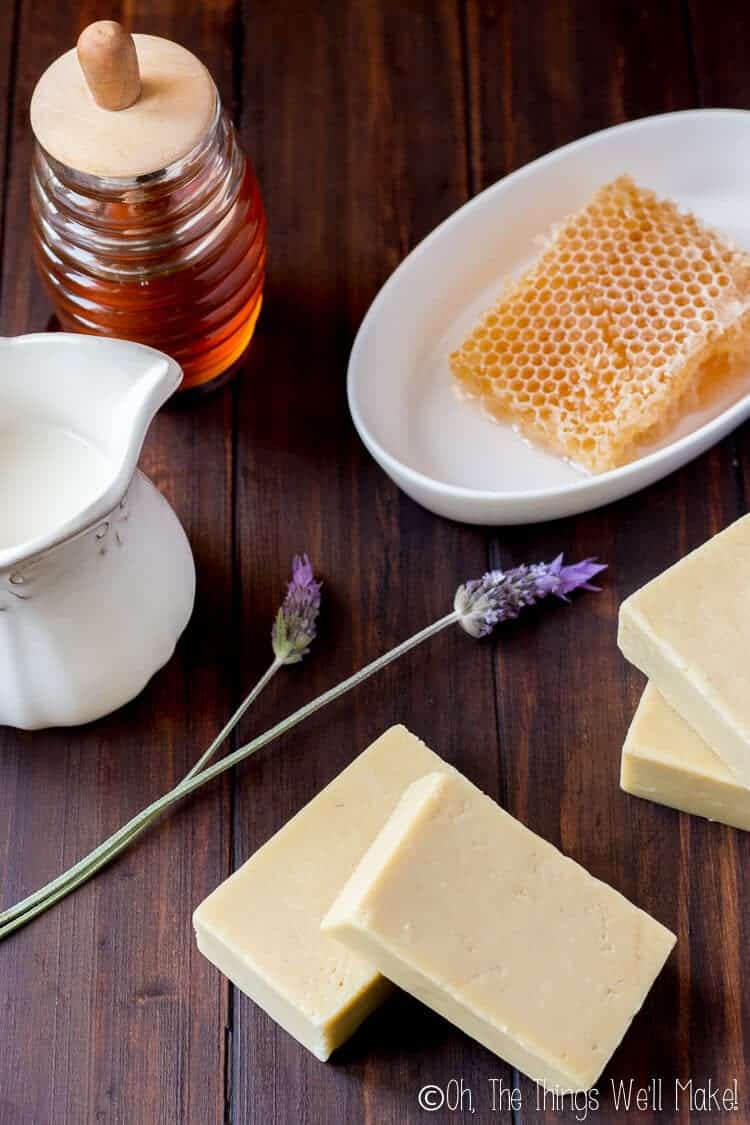
Adding honey to soap
Honey is another nice additive for soap. The sugar in the honey helps make a nice, bubbly lather. While honey is nourishing for your skin, too much honey can result in a soft bar of soap (especially if you don’t account for the liquid in honey by reducing the amount of water in the recipe).
Just like when adding milk to soap, the sugars in honey could burn if things heat up too much. There are several ways to add the honey to the soap without that happening. One solution is to add the honey to the oils, rather than the water, before combining them with the lye solution. By doing it this way, you aren’t making the lye solution with the honey in it. I haven’t tried that method yet myself.
I, instead, add the honey as soon as the soap reaches a light trace, and haven’t had any problems.
Reaching trace when working with cold ingredients
One of the trickiest things about making soaps using cold ingredients is being able to recognize when you’ve reached “trace.”
Trace is the point in soap making when the oils and lye have emulsified and the saponification process begins. If you don’t reach trace, your soap won’t set correctly or may have pockets of oils and/or lye within the areas of the soap that have set.
Avoiding “false trace”
Normally, to ensure you have reached trace, I’d have you blend until the soap thickens up slightly, almost like pudding. The problem with working with cold temperatures, though, is that the thickness of the soap mixture can be misleading. At cold temperatures, it may take a very long time to thicken up. On the other hand, if you’ve melted your coconut oil, it may begin to slightly solidify again as everything cools, making it appear that the mixture is thickening. This can lead to people thinking the mixture has reached trace when it hasn’t. This recipe doesn’t use enough coconut oil that I think that you’ll have problems with false trace, but it is something I wanted you to be aware of.
If you find your recipe isn’t thickening up after blending for several minutes, and you plan on pouring it into the molds at a light trace (thinner mixture), you’ll want to take special care to ensure that everything is well blended and that there are no streaks of oil anywhere in the mixture. (If in doubt blend for longer than you think you need to!)
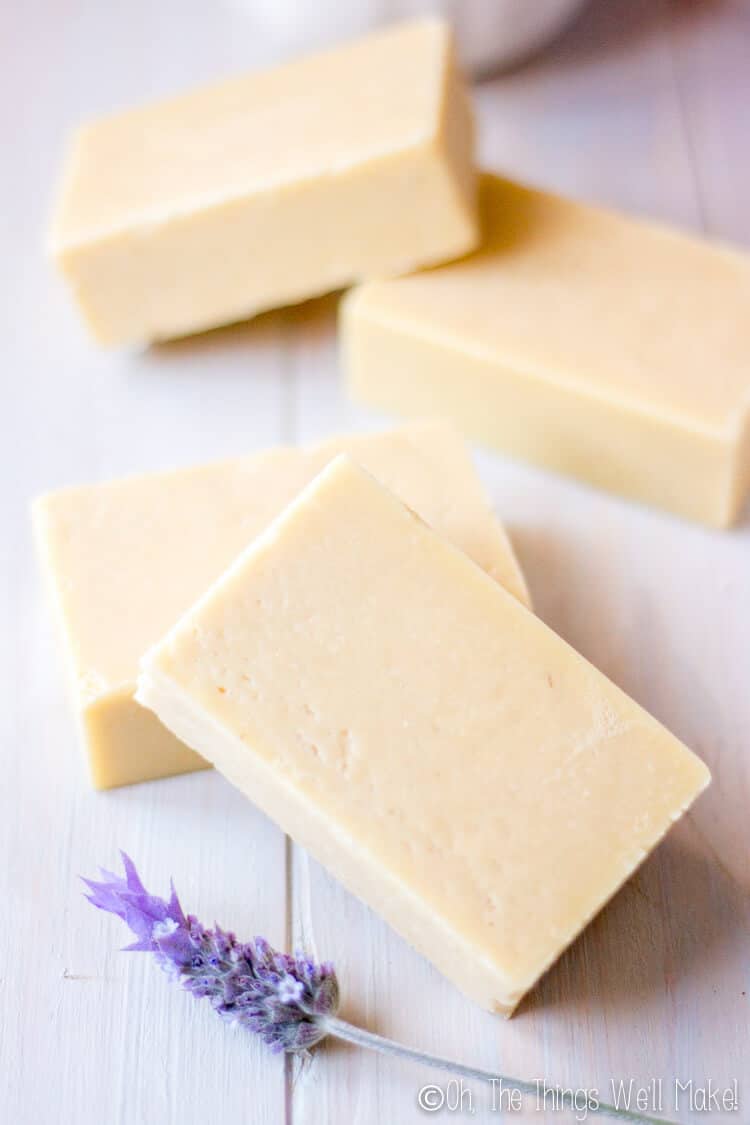
Goat milk soap with honey
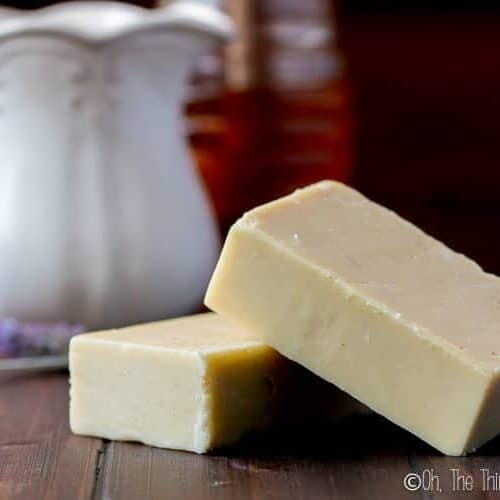
Goat Milk Soap with Honey
Fills up a loaf pan for 8-10 bars of soap
Materials
- 350 g olive oil
- 175 g coconut oil
- 75 g avocado oil
- 90 g distilled water
- 95 g goat milk
- 84.96 g lye
- 1 Tbsp. honey
Instructions
- Before beginning, freeze the goat milk to prevent it from burning when mixed into the lye solution. You can use it at the slushy stage or you can fully freeze it and use it in ice cube form.
- Weight out the distilled water and lye, and pour the lye into the container with water. (I like to use stainless steel bowls for this. Never pour the water into the container with lye.)
- Mix the lye into the water until it is fully incorporated. You’ll notice that the solution will heat up and become opaque, but if left will later cool off and become transparent again. (Work outside or in a well-ventilated area, and avoid inhaling the fumes. Protect your eyes and hands with gloves and goggles.)
- Add the frozen goat milk to the lye solution, and continue to stir as you incorporate it. It may turn slightly orange or brown due to the caramelization of the sugars in the milk reacting with the lye. To prevent it from burning, stir continuously until it has all melted and been fully incorporated into the solution.
- In a separate bowl, measure out the oils. You can weigh them all in the same bowl by taring (setting the weight to zero) your scale between oils. (In the video you’ll see that I was using solid coconut oil and didn’t melt it before using it. That was only to prove a point. I’d suggest melting the coconut oil to make the process move along more quickly and make things easier. There is no need to heat the other oils, though. If things get too hot you may end up scorching the sugars in the soap.)
- Add the lye solution to the oils and gently stir together until the lye solution has fully mixed with the oils.
- You can now begin to carefully blend together the oils and lye solution with an immersion blender. You’ll want to blend for several minutes, until your soap has reached “trace.” Trace is the point in soapmaking when the oils and lye have emulsified and the saponification process begins. (Read more about reaching trace in this soap above.)
- Once you’ve reached trace, you can add the honey and any essential oils or fragrance oils that you want to use. Blend until they’ve been fully incorporated.
- Pour the soap into soap molds. I used a silicone loaf pan for this recipe.
- If it is warm outside, you may want to pop your soap into the fridge or freezer to prevent having the soap partially gel. (You can read about the gel phase above.) Otherwise, leave it uncovered in a cool, ventilated area.
- After a couple of days, unmold the soap. If you’ve used a loaf type pan, cut the soap into bars.
- Allow the bars of soap to cure and dry for 4-8 weeks before using. (While you “can” use it before then without issues, the bars will harden and improve with time. Soaps will harden into longer-lasting bars and will mellow out during the curing process.)
- Enjoy your soap!
 Español
Español
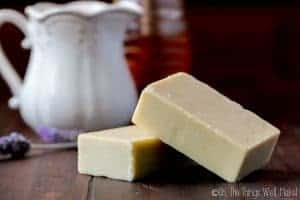
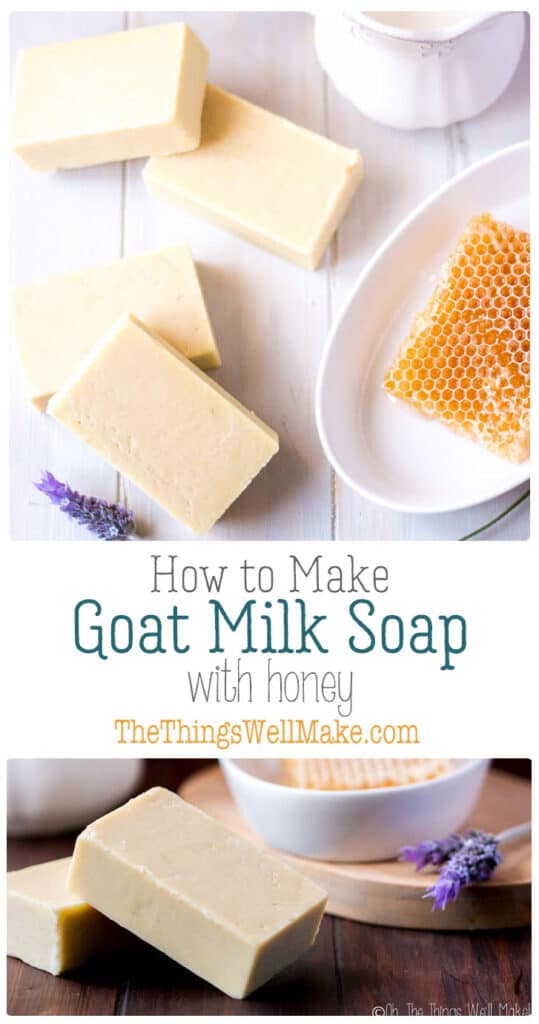
 Easy Homemade Barbecue Sauce Recipe
Easy Homemade Barbecue Sauce Recipe
Debs
I am a newly working up the courage to make this soap, but I would really like to use all goats milk and I was wondering do I add 90g extra frozen slushy goats milk to replace the distilled water?
Tracy Ariza, DDS
Hi Debs,
I haven’t tried it, but it should be fine. That’s how I would do it!
Sarah Mackie
Thank you Tracy – you have been my soap guru for months, although you may not have known it!
I want my soap to be extra nourishing too, so I’ll stick with the avocado oil in your recipe! I’ve been chatting about soaps with my 8-year-old girl this evening and she would really like to make a chocolate soap. She has dry, eczema prone skin so we’re thinking it’d need to be moisturising. Have you ever used cocoa butter in your soap making? Also do you think cocoa powder would work in a soap?
Tracy Ariza, DDS
Hi Sarah,
Aww, thanks!
I have used cocoa butter- and it’s great. But, no, I haven’t tried cocoa powder. That sounds like a lot of fun, though. I think it’s a great idea!
I’d love to hear how it goes.
Last week, I was remaking some of the soaps here to update the posts with new photos and video, etc.
I remade the charcoal bar and the pumpkin spice soap. I want to make a new version of the shave soap (this time with both types of lye).
Now that I’m in a soap making roll- maybe I’ll give something like that a try. If you beat me to it, though, I’d love to hear how it goes. 😉
Sarah Mackie
Hi Tracy. I’ve been using your beginner simple soap recipe up to now for my new soapy hobby, but just wondered, in this recipe is there any particular reason for the addition of avocado oil? Trying to work out whether to fork out on more oil because I fancy doing a nice milk and honey soap for some Christmas gifts! 🙂 Thank you,
Sarah x
Tracy Ariza, DDS
Hi Sarah,
Well, I was trying to make an especially nourishing soap. Avocado oil is a good oil for that. I also wanted to experiment with new oils and follow the recommendation of the lye calculator.
In the end, though, if you are happy with the beginner soap recipe, there is no reason that you can’t add goats milk to it by replacing part of the water content with that. You could also add a tiny bit of honey to it.
I actually have a recipe up on the blog that incorporated goats milk into the beginner soap recipe. (I think I did make the addition of one other oil, but you don’t need to do that. Just keep the oils and lye amounts the same if you like.)
Anyway, it’s my pumpkin spice soap. It also talks you through the process of adding goats milk to that soap.
I was actually working on updating that post this morning. I was planning on making a new batch tomorrow to have new pictures and, possibly, video. So, stay tuned if you’re interested in seeing the updates. 😉
Haley
Hello, have you ever tried it without coconut oil, with tallow, Shea, coco butter, etc? If so do you know a resource or a way to calculate the change? We are highly allergic to coconut.. but I love this recipe!
Tracy Ariza, DDS
Hi Hayely,
Any changes to soap recipes need to be run through a lye calculator. I have a post that talks about how to do that here.
You’ll probably want to sub the coconut oil with another solid oil to keep the soap hard and to get it to lather. (Perhaps lard or tallow?)
To better understand the differences in how an oil behaves in soap, I have a post about oils in soaps here.
Audrea
Also, is there a recommended rock-bottom for reducing the quantity of soap bars? For example, is it a good idea to (for pure experimentation) only make 1 bar of soap with this recipe (and would you divide everything by 10, or not?). Thanks so much, I can’t wait to get started with this!
Tracy Ariza, DDS
Hi Audrea,
The only problem I see is not having enough material to properly blend the ingredients together. I think it would be hard to mix together only enough for one bar. Otherwise, there is no problem that I could foresee as long as you divide all ingredients equally.
Audrea
Wow, what a lovely recipe! Just a few questions on the ingredients– Would you recommend substituting buttermilk for the goat’s milk (that isn’t available to me). And would Shea Butter have the same hardening qualities (in the same quantity) as Coconut Oil? Thanks for taking the time to share your knowledge and insights 🙂
Tracy Ariza, DDS
Hi Audrea,
I wouldn’t use shea butter in place of coconut oil, or you’ll end up with a soap that won’t lather. In soap recipes, you can’t switch out oils in the same quantity without running the new formulation through a lye calculator. (I have a post about how to use a lye calculator.)
You should be able to switch out the milk, though, without any issues.
Ella
I was wondering about the shelf life of goat’s milk soap, as I bought one that was adorable and smelled lovely, but when I got around to using it, the actual soap smelled like, well pardon me but PUS. >,< It was an experience alright! So I figured I had kept it too long. Have you found this, or is that just the nature of goat's milk soap? I've not tried making it myself, but I still dream of that cute little sheep soap sitting in a cloud soap holder.
Tracy Ariza, DDS
Hi Ella,
Wow! That sounds pleasant!
I haven’t had any issues with any of my soaps not keeping for long periods. In fact, I found that soaps like this one benefit from longer curing times- even several months!
I’m not sure why that would have happened. Perhaps, they brought the pH down with something and the soap was no longer self-preserving in the same way.
Angela Sanchez-Martin
Hello,
At what temperature did you add the lye solution to the oils? In the video, it looks like the goat milk cubes have not completely dissolved in the lye solution and that it may have been added at a high temperature….and it has confused me…I would very much love to try this soap, as I have just bought the goat milk to make a lotion and will have enough left over. Thank you for your wonderful and insightful recipes….as a bi-country citizen (US-Spain) myself, I really appreciate them.
Tracy Ariza, DDS
Hi Angela,
I don’t normally check. I normally mix the lye solution and allow it to sit while I prepare my other ingredients, then, I add it as soon as I’m ready. It’s generally warm, but not hot.
Bi-country citizens are the best! (In my completely unbiased opinion!) ;P
Marike Maior
Hi Tracy!
I am very sorry, english is not good. Whether it’s a soap recipe mix at temperature +30C(oils+lye)?
Your soap recipe is very good, but still be insecure, never has not made soap with so cold (oilsUsually mix at 30-60C).
Thanks and good luck!
Tracy Ariza, DDS
Hi Marike,
I’m afraid I’m not sure if I understood your question, but…
It’s OK to make the soap at cold temperatures. Hotter temperatures will make the process go more quickly. I kept the temperature low so that the milk doesn’t curdle.
Jad
Thank you Tracy, very well explained!
I was wondering, would I be able to replace goat milk by camel milk? And honey by dates molasses?
Would these changes require any adjustments to the recipe’s measurements?
Tracy Ariza, DDS
Hi Jad,
Yes, those changes should be fine. There is no reason to make any other changes, unless you were to switch out the type of oil used.